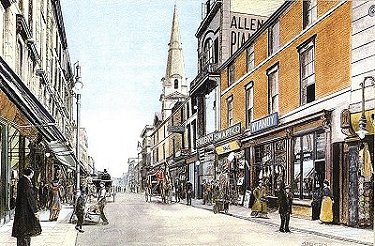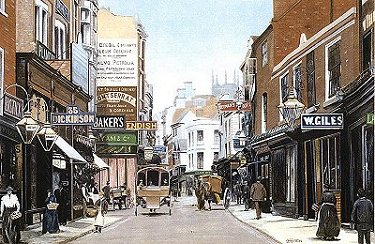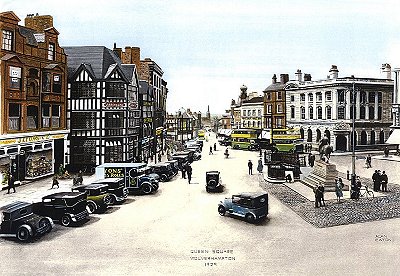 |
A Portrait of Wolverhampton
as viewed through the paintings of local artist
Alan Eaton
with commentary by Bev Parker |
 |
Introduction
When I first saw Mr. Eaton's paintings
I was greatly impressed by the attention to
detail and accuracy of his work. The examples shown here were copied from
photographs, some of which you may recognize. Although black and white
photographs are all that we have to accurately portray views of old
Wolverhampton, they lack a realism which only colour can offer. These images
provide that realism and leave the viewer with an unparalleled view of early
20th century street scenes, and a strong feeling of actually being there.
 |
Queen Street in about 1900.
This view of Queen Street shows a fine and elegant Victorian street.
This used to be
the main thoroughfare into town from the railway station entrance in the
Queen's
building, until the rebuilding of Lichfield Street and Railway Drive.On the
right is the Congregational Church which was built in 1865 and designed by
George Bidlake. It
was demolished in 1971. Also prominent is Allen's piano showroom, W. Tandy
butchers, and Webberley's wine and spirit merchants. |
Dudley Street in about 1900.
Even in 1900 this was a busy shopping area. The shops on the immediate left
were to disappear a few years later when Woolworths opened their store. The
store included
the premises of Hyam and Co., an old established gents outfitters who had
been there since the late 1870's. Most of these buildings have now
disappeared, but the familiar tower of St Peter's church is visible in the
background, as is the Barclays Bank building on the far side of Queen
Square, and the upper storeys of the Queens Hotel which is now Lloyds TSB
Bank. |
 |
 |
Queen Square in 1929.
This view of Queen Square shows a much quieter and less congested street
scene than we are used to today. On the left is the famous J. Lyons
restaurant, well known for its excellent cakes, one of their delivery vans
is parked outside. The next building is the mock-Tudor Shakespeare pub which
is an Atkinsons house. To its right is the popular Reynolds restaurant, and
the premises of Alfred Hall and Son who were one of the town's most
expensive tailors. Just visible at the top of Victoria Street is
Tyler's boot market. |
| On the far right-hand side of Queen Square is the dome of the
Hippodrome. It was built in 1898 as the Empire Palace of Varieties, and
became the Hippodrome in 1921. It was badly damaged by fire in 1956, and
demolished a little later. The white building to its right, and behind the
Wolverhampton bus is the old premises of Phillips and Jones which was a well
known furnishing store. The brick building next to it and behind the trolley
bus is the old Electric Theatre which opened at the end of January 1910.
Trolley buses started running here in October 1923 and Wolverhampton's
trolley bus system became the largest in the world. On the corner of
Exchange Street is the National Provincial Bank, which externally has
changed very little. The statue of Prince Albert is still in its original
position, and behind it are the public conveniences which were built in 1902
to cater for people visiting the Art and Industrial Exhibition. They are
believed to be the first in the country to cater for both men and women. |
 |
|
 |
Return to the
menu |
|
Proceed to the
next page |
|